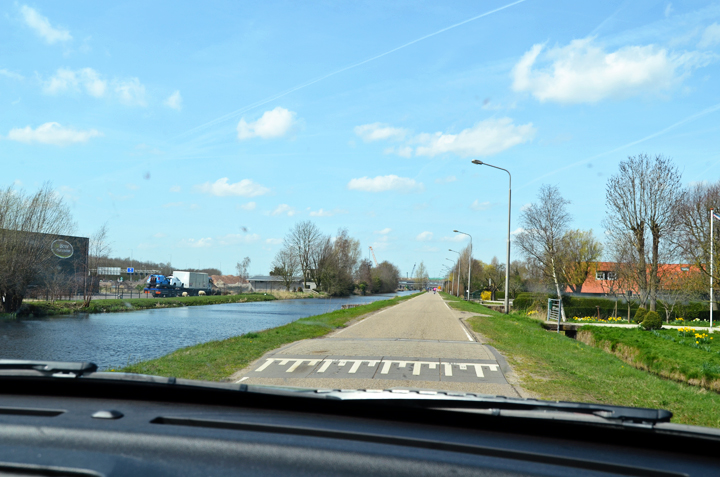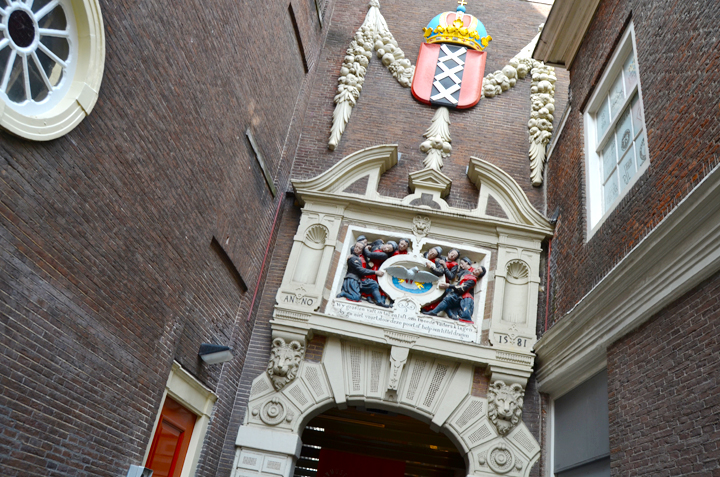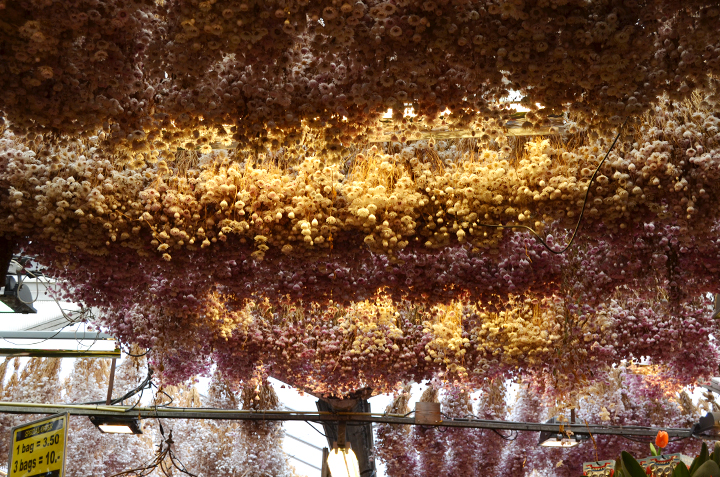On Sunday April 12th 2015 we hopped in the car and pointed our GPS to The Netherlands!
About 6 hours later we arrived. Kinda.
There was traffic so our GPS diverted us to a road that we were 100% sure was not actually a road for cars (why GPS, WHY?!) but then we saw cars driving in front of and behind us and ventured on...
About 6 hours later we arrived. Kinda.
There was traffic so our GPS diverted us to a road that we were 100% sure was not actually a road for cars (why GPS, WHY?!) but then we saw cars driving in front of and behind us and ventured on...
Yes, we (I mean, I) rented it solely for the pink couch.
The interior decor and design was super awesome and inviting.
Our airbnb host recommended a great parking lot right by the main train station (which was where our planned Rick Steves' walk started) so we plugged in the address to our GPS, found it no problem, parked, and headed out to explore the city.
Our first glimpse of the city! The basilica of St. Nicholas.Leaving the beautiful Central Station we headed down Damrak street.

We passed by the modern stock exchange at Beursplein square. This exchange is a joint venture by France, Belgium, and the Netherlands to compete with Britain's juggernaut stock exchange.
This is the old stock exchange building that was turned into a cultural center in 1984. It's built on (like almost every building in the city) a foundation of pilings - some 5,000 tree trunks hammered vertically into the soil.
A little further down Damrak is the historic heart of the city, Dam Square. The city got its start right here in the year 1250 when fishermen in this marshy delta settled along the built-up banks of the Amstel river. They built a dam blocking the river creating a small village called "Amstel-damme." With access to the sea the fishermen were soon trading with German riverboats traveling downstream and with seafaring boats from Stockholm, Hamburg, and London. Land trade routes converged here too and Dam Square was the center of it all. Today, Dam Square is still the center of Dutch life and is home to the Royal Palace, one of four official residences of King Willem-Alexander.
Next to the Royal Palace is the New Church which is only 100 years newer than the old church and is still 600 years old. The church's interior is often occupied by art exhibits that change every couple of months. It was closed for renovations or something.
A Madame Tussauds. We went to the one in LA. It was fun, and a little creepy. Some of those wax figures are too lifelike.
Get it? "Dam" Good Coffe? Hardy har. :)



Down from the church is the entrance to the Amsterdam Museum. On the arch above the entrance is Amsterdam's coat of arms - a red shield with three X's and a crown. The X-shaped crosses represent the crucifixion of St. Andrew, the patron saint of fishermen. They also represent the three virtues of heroism, determination, and mercy. But, considering the current things Amsterdam is known for, XXX is very fitting as a symbol for the city.
We didn't go in the city museum, but we want to check out the (free) Civic Guard Gallery. This hall features group portraits from Amsterdam's Golden Age. The portraits show the men gathered in their Civic Guard militia units. These men defended Holland, but the Civic Guards were also fraternal organizations of business bigwigs. There is also a portrait of the city's cultural leaders from 2006 posing as Golden Age bigshots.
Fox and Jane perusing the streets of Amsterdam.

This quiet courtyard lined with houses around a church has sheltered women since 1346. This was for centuries the home of a community of Beguines - pious and simple women who removed themselves from the world at large to dedicate their lives to God. When it was first established it literally was a "woman's island" - a circle of houses facing a courtyard surrounded by water.


Leaving the courtyard we crossed through Spui, a square lined with cafes and bars.
Back on a main drag called Ronkin we admired the vista.
The small statue is of Queen Wilhelmina (1880-1962) riding daintily sidesaddle. But, in real life she was the iron-willed inspiration for the Dutch Resistance against the Nazis.

Details from Amsterdam.

While there aren't many places for great views, a nearby shopping mall has a viewing platform.
The elevator was being serviced so I huffed it up the stairs.
Back on the ground we checked out Amsterdam's famous Bloemenmarket: the flower market. The market is a testament to Holland's long-time love affair with flowers, especially tulips.

A bicycle-lined narrow alley across from the flower market.

The "Golden Curve" of the Herengracht canal.


The Apple Store in what is probably the most expensive piece of real estate in the city.
Our end destination was Museumplein, bookended by the Van Gogh and Rijks museums. We weren't really looking for the famous I AMsterdam sign, but we found it! Plus, with the gorgeous Rijksmuseum in the background and the tulips in the fountain, this was a perfect place to get a family photo.


We paid the exorbitant admission price (17.50 euros! EACH!) and entered the museum. On the ground floor was probably the coolest thing we saw in the whole place, one of Van Gogh's actual palettes with some of his paints. Amazing.


Despite being out and about allllllllll day, we soldiered on and went to the Rijksmuseum.
After paying another exorbitant entrance fee (another 17.50 euros! EACH!) we plunged in.
Figuring out the floorplan was a little complicated, but eventually we made it up to the Great Hall covered in late-Victorian murals.
Then it was into the Gallery of Honor, home to all the Dutch big shots.Vermeer.
More Vermeer.
And even more Vermeer!
There are only about 34 Vermeers in existence and this museum has three. All in the same cove. Needless to say, it was packed around those three paintings.

Thus concluded day 1 of Amsterdam. We drove back to our wonderful, peaceful airbnb and recharged for the next day.

The Maggie Holmes buildings :)
So happy to find these! They're right outside Central Station, FYI.

The wonderfully crooked buildings on Molsteeg street.

Torensluis bridge is a square-like area with cafes and charming vistas. Much more relaxed than the crowded Dam Square.
A large bust of Multatuli, a Dutch writer, overlooks the bridge.
We had no plans to tour the Anne Frank House, but we wanted to go see it so we meandered in that general direction, passing by the "Homomonument," Amsterdam's AIDS memorial made up of several pink triangles.
A public "restroom." It is just a shielded area with drains on the ground that people pee in. It smelled so bad.
A nearby fry stand had creative artwork incorporating fries into famous works of art. Here is Van Gogh's The Potato Eaters. Hey, that totally works!
The lovely Westerkerk, or Western Church.

The organ.
Lovely riverboat.
Jane loving Amsterdam!

Eventually we wound up at the Anne Frank House. Line much?
Walking across the bridge to the other side of the canal we got a good view of the museum. I kind of wish they had maintained the exterior how it was when the Frank family hid here, but alas, the exterior was modernized.
Looking back on the Westerkerk spire was we delved deeper into the Jordaan neighborhood.Dald - make me a table like this m'kay? :)
Walking back to the car after two fun-filled days.
Bikes, bikes, and more bikes.

So colorful.
One last look at this amazing row of houses!
Next stop: Brussels, Belgium - country #20! But who's counting? :)









































































Gorgeous photos! I know they are 'known' for their liberal ways .... and I guess it works for them ... I remember the Red Light District being mentioned forever!!!
ReplyDeleteWhat a great city! I had fun exploring this town with you three!
ReplyDeleteI'm so enjoying reliving my old stomping ground through your visit & pics! I lived about 20 minutes outside of Ansterdam in college and went there often & have been to all of the places you highlighted. By the way, the Anne Frank House hadn't been modernized yet when I was there! Thanks for sharing!!
ReplyDelete